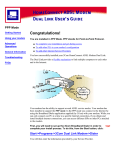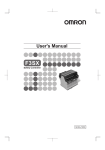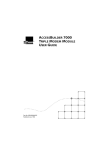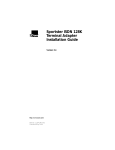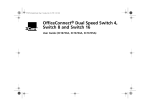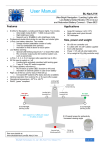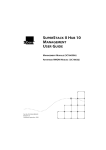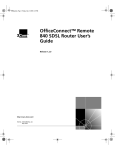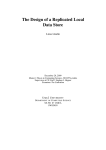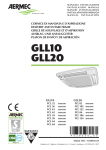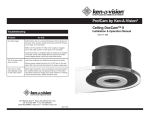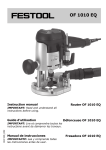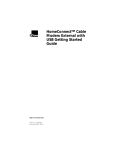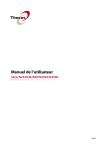Download OfficeConnectTM Remote 812 ADSL Router Getting
Transcript
OfficeConnectTM Remote 812 ADSL Router Getting Started Guide Version 1.0 http://www.3com.com/ Part No. 1.024.2427-00 Published February 2000 3Com Corporation 5400 Bayfront Plaza Santa Clara, California 95052-8145 Copyright ©2000 3Com Corporation. All rights reserved. No part of this documentation may be reproduced in any form or by any means or used to make any derivative work (such as translation, transformation, or adaptation) without written permission from 3Com Corporation. 3Com Corporation reserves the right to revise this documentation and to make changes in content from time to time without obligation on the part of 3Com Corporation to provide notification of such revision or change. 3Com Corporation provides this documentation without warranty of any kind, either implied or expressed, including, but not limited to, the implied warranties of merchantability and fitness for a particular purpose. 3Com may make improvements or changes in the product(s) and/or the program(s) described in this documentation at any time. UNITED STATES GOVERNMENT LEGENDS: If you are a United States government agency, then this documentation and the software described herein are provided to you subject to the following: United States Government Legend: All technical data and computer software is commercial in nature and developed solely at private expense. Software is delivered as Commercial Computer Software as defined in DFARS 252.227-7014 (June 1995) or as a commercial item as defined in FAR 2.101(a) and as such is provided with only such rights as are provided in 3Com’s standard commercial license for the Software. Technical data is provided with limited rights only as provided in DFAR 252.227-7015 (Nov 1995) or FAR 52.227-14 (June 1987), whichever is applicable. You agree not to remove or deface any portion of any legend provided on any licensed program or documentation contained in, or delivered to you in conjunction with this Install Guide. Unless otherwise indicated, 3Com registered trademarks are registered in the United States and may or may not be registered in other countries. 3Com, the 3Com logo, and OfficeConnect Remote 812 are registered trademarks of 3Com Corporation. 3ComFacts is a service mark of 3Com Corporation. Acrobat and Acrobat Reader aree trademarks of Adobe. Artisoft and LANtastic are registered trademarks of Artisoft, Inc. Banyan and VINES are registered trademarks of Banyan Systems Incorporated. CompuServe is a registered trademark of CompuServe, Inc. DEC and PATHWORKS are registered trademarks of Digital Equipment Corporation. Intel and Pentium are registered trademarks of Intel Corporation. AIX, AT, IBM, NetView, and OS/2 are registered trademarks and Warp is a trademark of International Business Machines Corporation. Internet Explorer, Microsoft, MS-DOS, Windows, Windows 95, and Windows NT are registered trademarks of Microsoft Corporation. Novell and NetWare are registered trademarks of Novell, Inc. PictureTel is a registered trademark of PictureTel Corporation. UNIX is a registered trademark of X/Open Company, Ltd. in the United States and other countries. Other brand and product names may be registered trademarks or trademarks of their respective holders. ii CONTENTS ABOUT THIS GUIDE Introduction Conventions 1 2 1 GETTING STARTED Introduction 1-1 What’s in the Package? 1-1 What Can the OfficeConnect Remote 812 do? 1-2 OfficeConnect Remote 812 Boot Mode Options 1-3 Option One: DHCP Smart Mode 1-3 Option Two: Default Bridge Mode 1-4 Option Three: Unconfigured Mode 1-4 2 INSTALLING THE OFFICECONNECT REMOTE 812 ADSL ROUTER Introduction 2-1 OfficeConnect Remote 812 Hardware Installation 2-1 Back Panel Features 2-1 Hardware Configuration 2-3 LED Light Operation 2-4 Workstation Configuration 2-4 Workstation Configuration Using DHCP Smart Mode 2-5 Workstation Configuration Using the Default Bridge Mode 2-5 Workstation Configuration Using the Unconfigured Mode 2-5 OfficeConnect Remote 812 Software Installation 2-6 Configuring the OfficeConnect Remote 812 Manager 2-7 Configuring in Bridge Only Mode 2-7 Configuring in DHCP Smart Mode 2-8 Configuring in Unconfigured Mode 2-8 Getting Started with the OfficeConnect Remote 812 Manager 2-9 Configuration Using the Remote Site Wizard 2-10 Remote Site IP Wizard field descriptions 2-11 Remote Site Name 2-11 Network Service 2-11 ATM VC Parameters 2-12 Network Address Translation 2-12 WAN IP Information 2-12 3 TESTING THE CONFIGURATION Introduction 4-1 General Testing 4-1 Step 1: Check Interface Status 4-1 Step 2: Check Network Status 4-2 IP Testing 4-3 Option 1: OfficeConnect Remote 812 Manager Ping to ISP or Remote Site Network 4-3 Ping Responses 4-3 DNS Errors 4-4 Option 2: DOS Ping to ISP or Remote Site Network 4-4 Option 3: Internet Browser (Internet Access Only) 4-5 Advanced Troubleshooting 4-6 A RESTORING THE FACTORY DEFAULT CONFIGURATION WITH THE RESET BUTTON Resetting the Configuration of Your Router B-1 B CONFIGURING YOUR WORKSTATION TO BE A DHCP CLIENT Workstation Configuration Using DHCP Smart Mode C SAFETY INFORMATION Important Safety Information C-2 Wichtige Sicherheitsinformationen C-3 Important notice de securite C-4 Medidas de seguridad importantes C-6 Informazioni importanti per la sicurezza C-7 A-1 C-7 D SPECIFICATIONS Introduction D-1 General Specifications D-1 Power requirements D-1 Temperature requirements D-1 Humidity requirements D-1 MTBF (Mean Time Between Failures) D-1 Jacks D-1 ADSL Interface (one RJ-11 jack) D-2 LAN Interface (four RJ-45 jacks) D-2 Console Interface (DB-9) (Default configured as DCE) D-2 FCC DECLARATION OF CONFORMITY 3COM CORPORATION LIMITED WARRANTY ABOUT THIS GUIDE Introduction The guide describes the features, installation, and initial configuration of the OfficeConnectTM Remote 812 ADSL Router. The guide is intended for both first-time and experienced computer network users who want to install and use the OfficeConnect Remote 812. If you are working with a bridge or router for the first time, it is possible you may make mistakes. We have tried to identify the likely errors you may make and have provided hints and tips to help you recover from error situations. With your new Remote 812, we have provided an Installation CD and an Installation Map. If you are using Windows, you should should put the Installation CD in your C-ROM drive and follow the steps given on the screens using your foldout Map. If your operating system is MAC or Unix based, you will commence by following the steps on the Map to set up the hardware and then copying (or referencing) files on the CD at Step 4. In Step 5, Configuring the Remote 812, you will follow the instructions given for the type of Boot Mode you have configured. There will be small differences in the procedure. Once you have carried out the initial configuration of the unit, you can carry out additional configuration to optimize the unit’s performance on your network. Refer to the OfficeConnect Remote 812 Online User’s Guide (install from your OfficeConnect Remote 812 Installation CD) for advanced configuration options and the Online HTML Help (click the context-sensitive help button at the bottom of each configuration screen) for more information. 2 ABOUT THIS GUIDE These and other user guides and release notes are available in Adobe Acrobat Reader Portable Document Format (PDF) or HTML on the 3Com World Wide Web site: http://www.3com.com/ Conventions Table 1 and Table 2 list conventions that are used throughout this guide. Table 1 Notice Icons Icon Notice Type Description Information note Information that describes important features or instructions Caution Information that alerts you to potential loss of data or potential damage to an application, system, or device Warning Information that alerts you to potential personal injury Table 2 Text Conventions Convention Description Screen displays This typeface represents information as it appears on the screen. The words “enter” and “type” When you see the word “enter” in this guide, you must type something, and then press Return or Enter. Do not press Return or Enter when an instruction simply says “type.” Keyboard key names If you must press two or more keys simultaneously, the key names are linked with a plus sign (+). Example: Press Ctrl+Alt+Del Conventions 3 Table 2 Text Conventions (continued) Convention Description Words in italics Italics are used to: n n n Emphasize a point. Denote a new term at the place where it is defined in the text. Identify menu names, menu commands, and software button names. Examples: From the Help menu, select Contents. Click OK. GETTING STARTED 1 Introduction This chapter provides instructions for pre-installation of the Remote 812. What’s in the Package? What can the Remote 812 do? Remote 812 Boot Modes What’s in the Package? Before you install the Remote 812 ADSL Router, check the contents of the box against the packed contents checklist below. If any of the items have been damaged in transit or are missing, contact the 3Com dealer from whom the equipment was purchased. Remote 812 Package Contents: Remote 812 unit Power adapter and power cord Ethernet cable (RJ45 — RJ45) DSL Modem cable (RJ11 — RJ11) Console cable (DB-9 — DB-9) Remote 812 ADSL Router Installation Map CD-ROM containing the Remote 812 ADSL Router Online User’s Guide (viewable in your web browser), the viewable and printable Remote 812 CLI User’s Guide (.pdf format), this Getting Started Guide (.pdf format), Remote 812 Manager help files, the Instant Update Install program, and the IP Wizard. Note: The Instant Update Install program and the IP Wizard are operational only for Windows users at this time. 1-2 CHAPTER 1: GETTING STARTED What Can the OfficeConnect Remote 812 do? The Remote 812 is a stand-alone BRouter with data interfaces to a Local Area Network (LAN) and a Wide Area Network (WAN). Below is a representation of how your Remote 812 connects a LAN and WAN. The Remote 812 contains one ADSL WAN interface port. It also provides support for ATM. The Remote 812 supports Point-to-Point Protocol (PPP) and RFC 1483 over the WAN interface.The LAN interface is a four-port Ethernet 10Base-T hub. The Remote 812 allows one or more networked workstations to connect to other computers on a remote LAN and can also provide high-speed access to the Internet. The Remote 812 provides static and dynamic routing of the Internet Protocol (IP) and Internetwork Packet Exchange (IPX) protocols as well as bridging, with support for learning bridge and 802.1d spanning tree functionality to eliminate loops. Other important features include: Routing Information Protocol (RIP), Simple Network Management Protocol (SNMP), address translation, telnet, and packet filtering. It can also provide DHCP services for your LAN, including automatic assignment of IP addresses to workstations. The web browser-based Remote 812 Manager and the IP Wizard provide a user-friendly configuration interface. OfficeConnect Remote 812 Boot Mode Options 1-3 OfficeConnect Remote 812 Boot Mode Options To simplify the installation process, the Remote 812 can be initialized with pre-configured parameters using the DIP switches located on the back of the unit. There are three Boot Mode options: DHCP Smart Mode Default Bridge Mode Unconfigured Mode It is important to note that these boot modes only take effect if the unit has not been previously configured. To erase the existing configuration, reference Appendix A. The DIP switch settings and the corresponding Boot Mode option are as follows: Table 1-1 DIP Switch Settings 1 2 3 4 Mode off on off off DHCP Smart Mode off off on off Default Bridge Mode, VPI=0, VCI=35 off off off on Default Bridge Mode, off off off off VPI=8, VCI=35 Unconfigured Mode Option One: DHCP Smart Mode You can use the DHCP Smart Mode if: You plan on using private addresses on the LAN (i.e. your Service Provider has provided you with only 1 public IP address), You plan on using the Remote 812’s DHCP Server The Remote 812 will power up with the following “DHCP Smart Mode” configuration: LAN IP address = 192.168.200.254, Netmask 255.255.255.0. DHCP IP address pool (40 addresses): 192.168.200.1-40 DNS name: ocrdsl-3com.com. 1-4 CHAPTER 1: GETTING STARTED Administrative Login profile, User Name: root and Password:!root Option Two: Default Bridge Mode Use this mode if you want the Remote 812 to function as a bridge automatically, with no special configuration. You will not be required to use the Setup Wizard or install any software from the CD unless you want to change the configuration or if you would like to use Instant Update in the event a software update to your Remote 812 is posted on 3Com’s web site (you can install from the CD at any time). Verify the VPI/VCI settings in the table above match values your Service Provider has given you. The Remote 812 will power up with the following configuration: Bridge network on the LAN Interface A remote site profile named “bridge” is set up to bridge all traffic with RFC 1483 encapsulation on the specified VPI/VCI. Spanning Tree Disabled Administrative Login profile: User Name: root and Password:!root Option Three: Unconfigured Mode Set all switches to OFF to boot your unit in Unconfigured Mode. You must set all of the configuration parameters. This allows you complete flexibility with your configuration. INSTALLING THE OFFICECONNECT REMOTE 812 ADSL ROUTER 2 Introduction In this release of the OfficeConnect Remote 812, we have provided an Installation Map and Install CD to assist in your setting up your unit and getting started. This chapter provides more information on the process for your assistance: OfficeConnect Remote 812 Hardware Installation Hardware Configuration LED Light Operation Workstation Configuration (and selecting a Mode) Remote 812 Software Installation Changing the Login Name and Password Starting the Remote 812 Manager Configuring the Remote 812 OfficeConnect Remote 812 Hardware Installation This section provides a quick hardware setup procedure for the Remote 812. Follow the steps below to learn more about setting up your router: Back Panel Features Below is a representation of the back panel. Familiarizing yourself with the connections will help in properly setting up your Remote 812. 2-2 CHAPTER 2: INSTALLING THE OFFICECONNECT REMOTE 812 ADSL ROUTER Console Port — You should not need to use the Console Port unless you are setting up in Unconfigured Mode and thus need to use the Command Line Interface (CLI) to configure your router. The DB-9 terminal port connects the Remote 812 with your console. Then you would use a terminal emulator program to access CLI and run Quick Setup and QuickVC. The Installation Map gives instructions. Reset button — This button resets the configuration of the router. See Appendix B for more information about resetting your router’s configuration with the reset button. DIP (Dual Inline Package) Switches (4) — Switches 1 through 4 can be turned on and off in certain combinations for different configurations. See the section titled “OfficeConnect Remote 812 Boot Options” in Chapter 1 for complete instructions on which switches to set for which options. Power Inlet — The power port attaches to an external, 15-volt DC power supply included in your package. The other end of the power supply cable connects to a standard electrical socket. Ethernet (LAN) Ports (4) — The shielded, 8-pin, RJ45 Ethernet (10Base-T) ports connect the Remote 812 with the LAN. A 10Base-T cable is supplied in the package to make this connection. MDI/X Switch — Swaps the transmit (Tx) and receive (Rx) signal pairs on Ethernet port 1. When MDI/X is “out” (not depressed), Port 1 is pinned the same as the remaining 3 ports. In this mode, a workstation’s Ethernet port or the cascade port on another hub can be connected to any of the four ports on the unit. When MDI/X is pressed “in,” then Port 1 on the unit becomes a cascade hub port, for connection to a non-cascade port on another hub. The MDI/X button must be “out” to use Port 1 for connection to a workstation. ADSL Modem Port — An RJ11 line port connects your Remote 812 to the telephone company wall jack. An RJ11 modem cable is provided. OfficeConnect Remote 812 Hardware Installation 2-3 Stacking Clip—A stacking clip is provided which will allow you to stack your OfficeConnect Remote 812 with other 3Com equipment if necessary. Hardware Configuration 1 Select a Boot Option — The Remote 812 has three boot options. These are controlled by the settings of the 4 DIP (Dual Inline Package) switches on the back of the unit. Boot options only affect the operation of a unit which does not presently have any configuration settings (i.e., the unit is new, the Configuration reset button has been pressed, or a delete configuration command has been executed from the CLI or Remote 812 Manager interface). See the section about DIP switch settings in Chapter 1, “Getting Started”. 2 Connect the DSL Modem Line — Use the modem cable provided to connect the Remote 812 ADSL port to telephone company wall jack. 3 Connect the Power — Connect the power plug to the back of the unit. Make sure the power plug is connected securely to the Remote 812. Then, plug the unit into an electrical outlet. 4 Connect to a Local LAN (select one of below) Connect directly to a workstation — Connect the 10Base-T cable into any LAN port. The MDI/X button must be out to use the LAN port furthest to the right(Port 1) to connect to a workstation. Up to four workstations can be directly connected to the Remote 812. Connect to an Ethernet Hub — Press the MDI/X button on the back panel so it is in the “in” position and plug the 10Base-T cable into the right-hand LAN port (Port 1). 5 Connect the Console Cable (optional) — If Windows is your operating system, you will not need to connect the console cable because you will use the Remote 812 Manager to configure your unit. The Remote 812 Manager uses a web browser instead of a Command Line Interface (CLI). If your operating system is MAC or Unix, you will be 2-4 CHAPTER 2: INSTALLING THE OFFICECONNECT REMOTE 812 ADSL ROUTER using CLI. Locate the serial cable included in your package. Connect one end of the cable to the DB-9 console port on the Remote 812 and plug the other end into a serial port on your workstation. The Remote 812 Hardware Installation is now complete. Continue with the next section to verify your Remote 812 is operating correctly. LED Light Operation After you boot up, the LEDs indicate whether the Remote 812 is working properly and when certain features are in use. There are four sets of LEDs on the Remote 812. They operate as shown in the following table: Table 2-1 LED Group LED Operation LED Indicator Alert Status Operation Flashing Software is initializing. Power Power ON Power is on. ADSL Link Status ADSL connection OFF No signal has been detected.* Green Link is up. Blinking Green Link is up, data transfer is occurring. Orange The unit is attempting to achieve synchronization with the CO equipment. ON A client is connected to the corresponding port on the hub. LAN Status (Ports 1-4) Client Connection If an LED is not operating properly, consult the OfficeConnect Remote 812 Online User’s Guide and refer to the section on Troubleshooting. * If the ADSL LED is off, there may be a problem with the ADSL cable or line. However, you can continue setting up your Remote 812 even if the ADSL Link Status LED is off. Workstation Configuration The IP configuration on your Workstations must correspond with the Remote 812 configuration. The Workstation Configuration 2-5 following sections detail your options given the Boot Mode you have selected. Workstation Configuration Using DHCP Smart Mode If you have chosen to utilize DHCP Smart Mode, you will need to configure some parameters on your workstation. For DHCP Smart Mode, you must set up all workstations on the Remote 812’s LAN to automatically obtain their IP address. This is the default setting in Windows 95. If you have configured IP addresses manually on your workstation, verify that the IP address is on the 192.168.200.0 Class C subnet and that the default router is 192.168.200.254. Note: Refer to Appendix B for instructions on how to change or verify that your workstation is configured for automatic assignment of an IP address and corresponding parameters. After you have configured your workstation, proceed to the next section, “Software Installation”. Workstation Configuration Using the Default Bridge Mode When the Remote 812 is configured as a bridge, refer to your Service Provider’s instructions on how to set up your workstation. Proceed to Chapter 3, “Testing the Configuration”. Workstation Configuration Using the Unconfigured Mode When the Remote 812 is not configured with an IP address on the LAN, you must use the IP Wizard program, which is included on your CD, or connect to the console port to configure an IP address before you can access the unit with a Web Browser. Proceed to the next section, Office Connect 812 Software Installation, for instructions on installing the CD. Then, if you are using Windows, refer to the subsequent section, Assigning an IP Address with the IP Wizard. The IP Wizard will detect your Remote 812 on the LAN and then prompt you to specify the IP address you want to configure it with. 2-6 CHAPTER 2: INSTALLING THE OFFICECONNECT REMOTE 812 ADSL ROUTER If you are using MAC or Unix, you will need to use the console port and a terminal emulator program to access CLI, using the settings: 9600 Bits per Second, 8 Data Bits, No Parity, Flow control equal to Xon/Xoff. Refer to the CLI Users Guide (which is a .pdf file on the Install CD) for a description of the commands to use. OfficeConnect Remote 812 Software Installation The Remote 812 Install CD contains the Online Guides, the IP Wizard Utility, and the 3Com Instant Update software. The IP Wizard and Instant Update are available at this time only for Windows users. If you are a Windows user and are doing a normal install, your install CD should be automatically copying the basic files you need to complete your installation at this point. The CD also contains Microsoft Internet Explorer 4, and Adobe Acrobat Reader 3.01. If you are a MAC or Unix-based user, copy or refer to the CLI Users Guide for instructions on using the CLI and the “Quick Setup” and “QuickVC” programs to complete your installation. If you do not have at least Microsoft Internet Explorer 3.02 or Netscape Navigator 3.0, you should install the Microsoft Internet Explorer 4 included on this CD in order to use the web-based OfficeConnect Remote 812 Manager for configuring your Remote 812. You must also have Adobe Acrobat Reader installed to view the PDF formatted CLI Guide included on this CD. If you are not installing the Remote 812 at this time but you want to copy the information and help files, you may do so from the Install CD Main Menu: The Remote 812 is shipped with its operational software pre-installed in the unit’s FLASH memory. A copy of the operational software is also provided on the CD. The Remote 812 operational software (the *.nac file) included on the CD is copied to your hard drive and not the Remote 812 unit. Unless you specify otherwise, it is Configuring the OfficeConnect Remote 812 Manager 2-7 installed to the default location: C:\Program Files\3Com\ocr812\1_0\Update If you need to reload the software on your unit, please refer to the OfficeConnect Remote 812 ADSL Router Online User’s Guide (on your installation CD). If you need to install Microsoft Internet Explorer 4, launch the installation by putting the Remote 812 Installation CD in your CD-ROM drive and selecting “Install Internet Explorer 4” from the menu. If you need to install the Adobe Acrobat Reader to view your printable files, launch the installation by putting the Remote 812 Installation CD in your CD-ROM drive and selecting “Install Adobe Acrobat 3.01” from the menu. You may optionally choose to install the 3Com Instant Update utility. Launch the installation by putting the Remote 812 Installation CD in your CD-ROM drive and selecting “Install 3Com Instant Update” from the menu. Instant Update periodically checks the 3Com web site for a new release of the Remote 812 code. When a new release of the code is found, Instant Update copies it to your workstation. You will then need to install the code onto your Remote 812 unit. This procedure is explained in the OfficeConnect Remote 812 ADSL Router Online User’s Guide (on your Installation CD). Configuring the OfficeConnect Remote 812 Manager Configuring in Bridge Only Mode If you selected Bridge Only Mode as your Boot Option, no further action is needed. You should be connected to your ISP or remote office. If you can’t access the remote site, examine the DIP switch settings on your unit. To reset to a different Boot Mode, change the DIP switch settings and then hold the reset button (on the back of the router) in for five seconds while powering on the router. 2-8 CHAPTER 2: INSTALLING THE OFFICECONNECT REMOTE 812 ADSL ROUTER If you selected DHCP Smart Mode or Unconfigured Mode, your Remote 812 must be assigned an IP address in order for your web browser to communicate with it. You must also have an administrative login profile (user name and password) assigned. If you assign the IP address with DHCP Smart Mode or with the IP Wizard, the administrative login name is root and the password is !root. After you access the unit with your web browser, you are strongly advised to delete this login profile and create a new one with a secure name and password. (Maximum character length of login name = 32, password maximum character length = 15.) Configuring in DHCP Smart Mode In Windows, the browser will automatically launch at the conclusion of your automated installation procedure and you will have the assistance of the IP Wizard. In MAC or Unix, you must manually start the browser. Proceed to the section: Getting Started with the OfficeConnect Remote 812 Manager Configuring in Unconfigured Mode Windows Users: Windows users will have the assistance of the IP Wizard, as in DHCP Smart Mode. You will need to input a static address that agrees with other addresses on your LAN. The IP Wizard: IP Wizard will search the LAN for all unconfigured Remote 812s. As each unconfigured unit is found, the unit’s MAC address is placed in the selection box. For multiple Remote 812s, you can determine which MAC address belongs to the one you want to configure by disconnecting the Remote 812’s Ethernet cable and running IP Wizard again. The missing MAC Address belongs to that Remote 812. If the IP Wizard does not find any unconfigured units, and you are sure your unit is unconfigured, refer to the chapter on Troubleshooting in the OfficeConnect Remote 812 ADSL Router Online User’s Guide. Configuring the OfficeConnect Remote 812 Manager 2-9 Select which Remote 812 you want to configure and enter its LAN IP address and netmask; then press Set. Proceed to the next section. MAC and Unix Users: MAC and Unix users (and those configured in Bridge Only Mode but with alternate VPI/VCI settings) will be using Command Line Interface (CLI). Connect the console cable provided with the Remote 812 kit to the router and a Com port on your workstation. Use a terminal emulator program to access the Command Line Interface, using the following settings: Bits per second: 9600 Data Bits: 8 Parity: None Flow control: Xon/Xoff Then run Quick Setup and then QuickVC. Getting Started with the OfficeConnect Remote 812 Manager 1 When your web browser opens up, to get to the Remote 812 “home page,” either enter the unit’s LAN IP address or, if DHCP Smart Mode is in use, the DNS host name (ocrdsl-3com.com) into the Location or Address field of your web browser. Notice that typing the http:// is optional (for example, you can type simply 192.168.200.254). 2 The web browser will then prompt you to log in. Enter the administrative login name and password (default login name root and Password !root). 2-10 CHAPTER 2: INSTALLING THE OFFICECONNECT REMOTE 812 ADSL ROUTER After successful authentication, you will be presented with the Remote 812 “Wizard page.” If you do not see this screen, refer to the section on Troubleshooting in the Online User’s Guide (install from your CD). Configuration Using the Remote Site Wizard When you first connect to the Remote 812 Manager and a VC profile has not yet been configured, you will be automatically directed to the Remote Site Wizard page shown below. This page prompts the User for the bare minimum information it takes to set up a Remote Site profile to your ISP. Once the Remote Site has been configured, the user will be directed to the Remote 812 Home Page, where he or she will have access to a more advanced feature set. Configuring the OfficeConnect Remote 812 Manager 2-11 A description of each field follows. After you have entered in your configuration, when you want to send down the configuration to the Remote 812, press the “configure” button. You will then be redirected to the OfficeConnect Remote 812 Home page. If you do not want to configure the Remote Site profile, press the “cancel” button and you will be redirected to the OfficeConnect Remote 812 Home page. If you want to access additional features not provided to you when using the Remote Site Wizard, access the Remote Site profile from the Home page by selecting Configuration, then Remote Sites. Remote Site IP Wizard field descriptions Remote Site Name The Remote Site Name is used to identify the profile and it’s associated parameters. The name can be up to 32 characters and typically describes the remote site you are connected to, such as my_isp or my_corp. Network Service Your Service provider should provide you with the type of Network Service to configure for your WAN connection. The Remote 812 supports the following Network Services: PPP – The Point to Point Protocol is a WAN interface protocol between the Remote 812 and your ISP’s Remote Server. The protocol provides built in negotiation for addresses and connection parameters, and can route multiple protocols over a single link. RFC 1483 – Is a defined protocol standard that describes two encapsulation methods for carrying network traffic over ATM AAL5. The encapsulation methods; routed and bridged, must be configured the same on both ends of the link. To select routed encapsulation, select RFC 1483. To select bridged encapsulation, select RFC 1483 with MAC encapsulation. RFC 1483 with MAC encapsulation – specifies RFC 1483 with a bridge encapsulation. This feature enables the Remote 812 to function as a router but to work in a 2-12 CHAPTER 2: INSTALLING THE OFFICECONNECT REMOTE 812 ADSL ROUTER bridged environment. When enabled, the network level addresses are used for forwarding, but the MAC layer addresses are pre-pended in the ethernet header over the Wide Area Connection. ATM VC Parameters Your Service provider should provide you with the Virtual Path Identifier (VPI) and Virtual Connection Identifier (VCI) values to configure for your connection. These are pre-assigned virtual path information used to route ATM cells through the network to your ISP. Network Address Translation This feature enables many workstations on the LAN to share a single public address when accessing information over a public network (Internet). Enable this feature if you have a Single User Account with your ISP and disable it if you have been provided public IP addresses to use on the LAN. WAN IP Information Your Service provider will provide you with the public IP address(es) to use on your WAN Interface or on the LAN. If you have selected PPP as your Network Service, the WAN IP addresses will be dynamically learned from the Remote PPP Server. The Remote 812 will not prompt you for WAN IP Information if PPP has been selected. If you have selected RFC 1483 and have enabled Network Address Translation (NAT), you will be prompted for the WAN interface Address. This is the single public address that will be shared by all privately addressed clients on your LAN when they access the public network. You will also be prompted for a corresponding netmask, which will default to a class C (255.255.255.0) value. If you have selected RFC 1483 and have not enabled NAT, you can configure a WAN Interface address or a Remote Subnet address and corresponding netmask. When selecting RFC 1483 with MAC encapsulation, you must specify the Remote Gateway Address. If you have Configuring the OfficeConnect Remote 812 Manager 2-13 enabled NAT, you will also be prompted for the WAN interface. If you did not enable NAT, the WAN interface address is optional. If you do not configure the WAN Interface address, the Remote 812 LAN ethernet address should be a public address. TESTING THE CONFIGURATION 3 Introduction This chapter contains information on testing the Configuration. General Testing IP Testing Advanced Troubleshooting General Testing After configuring the OfficeConnect Remote 812 for remote site connection(s), follow these steps to test the connections. Step 1: Check Interface Status 1 Be sure the DSL cable is connected to the OfficeConnect Remote 812 and the phone jack, and then check the ADSL Status LED on the front of the unit. It should be green or blinking green. 2 If the unit is not in a location where you can see the LEDs, go to the OfficeConnect Remote 812 Manager home page. Select Monitor > Interface Status. The following table should display: Ensure that Oper Status of interface atm:1 is UP. If the status of atm:1 is not UP, check the cable connection to make sure it is securely plugged into the unit and check 3-2 CHAPTER 3: TESTING THE CONFIGURATION the cable to make sure it is not damaged. If there are no apparent cable problems, contact your service provider. Step 2: Check Network Status Check that all LAN and WAN networks are up. From the OfficeConnect Remote 812 Manager “home page,” select Monitor > Networks > Network Status. You should see one active network for each of the LAN protocols configured (IP, IPX, and/or Bridge). You should also see an active network for each of the protocols configured over each remote site. For example, if you have a remote site profile for Internet access, you should see a corresponding IP network in the table. If you are connected to a remote office, with IP routing, you should see corresponding networks for this, too. Below is an example wherein an IP network is configured over the LAN (indicated by eth:1), and the remote site “red” is configured for IP over the WAN (indicated by atm:1). If you don’t see the expected networks, there is probably a remote site profile configuration error. You should check the following in the Configuration > Remote Site (WAN) screens. Is the remote site enabled? Is the protocol (IP) enabled? Are the network addresses correct? Is the Network Service (PPP or RFC 1483) correct? Is the remote site profile ATM information (VPI / VCI) correct? If necessary, contact your ISP or remote site administrator to confirm the information provided to you. When all IP Testing 3-3 problems are resolved, continue to the IP testing section below. IP Testing Run a PING to make sure the OfficeConnect Remote 812 can reach the remote router. You can PING by using the OfficeConnect Remote 812 Manager, from MS-DOS, or test the connection through your Internet Service Provider. PINGing from the OfficeConnect Remote 812 Manager will test the connection from the OfficeConnect Remote 812 to the network. The DOS PING will check the connection from your PC through the OfficeConnect Remote 812 ADSL Router to the network. You can also test the connection using your Internet Browser, if you have Internet access. Option 1: OfficeConnect Remote 812 Manager Ping to ISP or Remote Site Network Open the OfficeConnect Remote 812 Manager, select Tools > Ping. Enter the address you wish to ping, whether it is the ISP or a remote site. Press the Submit button. A Ping Response screen will appear, with the response from the ping. The following responses may occur. Ping Responses <IPAddress> is alive The PING was successful. If a name was entered in the Ping page input field, the corresponding IP address is displayed on the Response page. PING: no route to host A valid IP address or name was entered but the routing table does not indicate how to reach the network that the IP address belongs to. 3-4 CHAPTER 3: TESTING THE CONFIGURATION PING: host unreachable This means that the IP address is currently unreachable. This is indicative of a network problem. The router sent the message either to the specific network to which the IP address belongs or to a default gateway. If it was sent to the specific network and the network was learned via RIP, there is probably a temporary network problem. If the network is a static entry in the routing table, it may have been entered incorrectly. PING: timeout waiting for reply from <IP Address>. The host network is probably reachable but there is no answer from this IP Address. There are a couple of possible explanations for this: The IP Address might not be assigned to any unit; the path from the OfficeConnect Remote 812 to the unit is so slow that the PING response did not get back in the allotted time frame; or there may be a temporary break in the path. DNS Errors Network Name: <name> could not be resolved. Network Name: <name> could not be resolved due to a problem interacting with the Name Server. The name could not be resolved. Either no DNS server was located or the server(s) did not have the name in the host table list. This error will also appear if the user entered an invalid IP address such 10.100.100.256. Network Name: <name> could not be resolved due to a timeout on the request. No response was received from the DNS server to which the DNS request was sent. This could be due to a network connection problem or Internet congestion. Option 2: DOS Ping to ISP or Remote Site Network 1 From the a workstation on the local LAN, get to an MS-DOS prompt and type ping <remote IP address> <enter> where the remote IP address is the address of a host on the remote network (Ex: ping 10.0.0.12). If no IP Testing 3-5 address was provided, contact the ISP or the remote site administrator for an IP address to ping. 2 The OfficeConnect Remote 812 will send the PING request. A reply from 10.0.0.12 indicates success. An example script of a failed ping is: C:\ping 10.0.0.12 Pinging 10.0.0.12 with 32 bytes of data: Request Request Request Request timed timed timed timed out. out. out. out. An example script of a successful ping is: C:\ping 10.0.0.12 Pinging 10.0.0.12 with 32 bytes of data: Reply Reply Reply Reply from from from from 10.0.0.12 10.0.0.12 10.0.0.12 10.0.0.12 bytes=32 bytes=32 bytes=32 bytes=32 time=140ms time=147ms time=140ms time=135ms TTL=240 TTL=240 TTL=240 TTL=240 C:\_ It is not unusual for the first few attempts to time out. If you don’t receive a response the first time, try PINGing the router again. If you still don’t receive a response, the most likely cause is incorrect routing entries. Option 3: Internet Browser (Internet Access Only) If you are connecting to the Internet, start a web browser and enter an address, such as http://www.3com.com. If the 3com web site home page comes up, all is configured correctly and you are on your way! If the 3Com web site home page does not appear, the problem may be incorrect DNS server addresses on your workstation. To investigate other possible problems, refer to the section on Troubleshooting in the OfficeConnect Remote 812 ADSL Router Online User’s Guide. 3-6 CHAPTER 3: TESTING THE CONFIGURATION Advanced Troubleshooting For more detailed troubleshooting information, refer to Troubleshooting in the OfficeConnect Remote 812 ADSL Router Online User’s Guide (on your Installation CD). RESTORING THE FACTORY DEFAULT CONFIGURATION WITH THE RESET BUTTON A Resetting the Configuration of Your Router To reset your unit and select a different boot option: Unplug the power cable from your OfficeConnect Remote 812. Set the appropriate DIP switch. Plug the power cable back WHILE pressing in the Reset button on the back of your router for five seconds. Following the above steps will power on the OfficeConnect Remote 812 with the desired boot option and erase all previous parameters. B CONFIGURING YOUR WORKSTATION TO BE A DHCP CLIENT Workstation Configuration Using DHCP Smart Mode If you have chosen to utilize DHCP Smart Mode, you will need to configure some parameters on your workstation. You should set up the workstations on the OfficeConnect Remote 812’s LAN to automatically obtain their IP address. This is the default setting in Windows 95. If you have configured IP addresses manually on your LAN, you should use the following procedure on each workstation to allow them to automatically learn the new addresses instead The following is an example of this procedure on a workstation running Windows 95. 1 Open the Control Panel. Select Network > Configuration > TCP/IP to access the TCP/IP Properties Menu. Select the Gateway tab. Remove any IP addresses in the Installed Gateways field. B-2 APPENDIX B: CONFIGURING YOUR WORKSTATION TO BE A DHCP CLIENT 2 Select the IP Address tab. 3 Check the Obtain an IP Address Automatically button. This will cause the workstation to request an IP address from the OfficeConnect Remote 812. 4 Select the DNS Configuration tab. Workstation Configuration Using DHCP Smart Mode B-3 Be careful not to remove the Host Name accidentally, if there is one in the box. Remove any DNS servers listed after the DNS Server Search Order field. Accept all of the networking changes. Reboot your workstation, then proceed to the next section, Software Installation. C SAFETY INFORMATION When using the unit, observe the following safety information: Retain this user guide for later use and pass it on to subsequent owners/managers of the unit. The power adapter supplied with the unit is fitted with a molded plug for connection to a standard electrical mains system supply socket. If this plug is not suitable for connection to your mains supply, contact your reseller for advice. Do not attempt to connect to the mains supply using an inappropriate mains adapter. Protect the unit from sudden, transient increases and decreases in electrical power by fitting it with an in-line surge suppressor or uninterruptible power supply. Products manufactured by 3Com are safe and without risk provided they are installed, used, and maintained in good working order and in accordance with their instructions and recommendations. Should any of the following conditions occur, isolate the electricity supply and refer to your 3Com reseller. If the case or cover is not correctly fitted. If the case is damaged. If the unit begins to make an odd noise, smell or smoke. If the unit shows signs of a distinct change in performance. Never install telephone wires during a thunder storm, or install telephone connection sockets in wet locations (unless the socket is specifically designed for wet locations). Do not touch uninstalled telephone wires or terminals unless the telephone line has been disconnected at the network interface. Always exercise caution when installing or modifying telephone lines. Do not spill food or liquids on the unit. If the unit gets wet, isolate the electrical supply and contact your 3Com reseller. Do not push any objects into the openings of the unit. Doing so can cause fire or electric shock by shorting out internal components. C-2 APPENDIX C: SAFETY INFORMATION Ensure nothing rests on the unit’s system cables and that the cables are not located where they can be stepped on and cause damage to the unit. Keep the unit away from radiators and heat sources. Allow 25 mm (1 inch) around the unit or stack to provide adequate air circulation. Install the unit in a clean area that is free from dust or extreme temperatures. The unit has been designed to be a free-standing unit or stacked with other OfficeConnect Remote units. Do not place anything else on top of the unit’s case. Allow a clearance gap of at least 50 mm (2 in) from the rear panel of the unit, to allow for cable access. This unit contains a lithium battery which is attached to a microchip on the printed circuit board. The defective battery must be disposed of safely in accordance with the manufacturers instructions. Cette unité contient une pile au lithium attachée à une puce sur la carte à circuit imprimé. Se débarrasser de la pile défectueuse en toute sécurité conformément aux instructions du fabricant. Normal operations of this unit could be interrupted by a lightning surge. In this event, the user must recycle the power to the unit in order to establish normal operating conditions. Important Safety Information WARNING: Warnings contain directions that you must follow for your personal safety. Follow all instructions carefully. Please read the following information carefully and thoroughly before installing the unit: Take exceptional care during the installation and removal of the unit. Locate the unit close to the main socket outlet, and ensure that the main socket is accessible. Use the power adapter supplied with the unit to ensure compliance with national and international safety standards. If there is no power adapter supplied, the main cordset used must be compliant with the local and national regulations of the target country and must not violate the safety approval of the product (refer to the section at the back of this manual). C-3 Disconnect the power adapter before moving the unit. Power can only be disconnected from the unit by removing the power adapter from the unit or from the socket outlet. Only connect apparatus complying with the relevant interface requirements to the ports on this unit. The safety status of the ports on this equipment are as follows. Ports identified by the labels XXXX and YYYY = TNV. TNV (Telecoms Network Voltage) is a circuit which, under normal operating conditions, carries telecommunication signals. Ports identified by the labels AAAA and BBBB = SELV. SELV (Safety Extra Low Voltage) is a secondary circuit which is designed and protected so that under normal and single-fault conditions, the voltage between any two accessible parts does not exceed a safe value (42.2 V peak or 60 V DC). There are no user-replaceable fuses or user-serviceable parts inside the unit. If there is a physical problem with the unit that cannot be solved with problem solving actions in this guide, contact the 3Com reseller from whom the equipment was purchased. If the units are stackable, only stack similar units. WARNING: Twisted Pair RJ45 data ports. These are shielded RJ45 data sockets. They cannot be used as telephone sockets. Only connect RJ45 data connectors to these ports. Wichtige Sicherheitsinformationen WARNUNG: Warnungen enthalten Anweisungen, die Sie zu Ihrer persönlichen Sicherheit befolgen müssen. Bitte halten Sie sich daran. Bitte lesen Sie die folgenden Informationen aufmerksam, ehe Sie die Einheit installieren: Lassen Sie bei Installation und Abbau besondere Vorsicht walten. Stellen Sie die Einheit in der Nähe einer Stromquelle auf und achten Sie darauf, daß diese zugänglich ist. Verwenden Sie immer den mitgelieferten Netzadapter, damit die Einhaltung nationaler und internationaler Sicherheitsnormen gewährleistet ist. Wurde kein Adapter mitgeliefert, muß das verwendete Netzkabel den lokalen und nationalen Bestimmungen des Landes entsprechen und darf die Sicherheitsbestimmungen des Produkts (siehe den C-4 APPENDIX C: SAFETY INFORMATION entsprechenden Abschnitt am Ende dieses Handbuchs) nicht verletzen. Trennen Sie den Netzadapter von der Stromversorgung, bevor Sie die Einheit bewegen. Die Einheit kann nur von der Stromversorgung getrennt werden, indem Sie die Verbindung des Netzadapters entweder von Einheit oder der Stromquelle trennen. Schließen Sie nur Geräte an den Schnittstellen dieser Einheit an, die den Interface-Voraussetzungen entsprechen. Die Sicherheitsmerkmale der Schnittstellen dieses Geräts sind: Schnittstellen mit der Bezeichnung XXXX und YYYY = TNV. TNV (Telecoms Network Voltage) ist ein Schaltkreis, auf dem unter normalen Betriebsbedingungen Telekommunikationssignale übertragen werden. Schnittstellen mit der Bezeichnung AAAA und BBBB = SELV. SELV (Safety Extra Low Voltage) ist ein sekundärer Schaltkreis, der unter normalen und Single-Fault-Bedingungen so eingerichtet ist, daß die Spannung zwischen zwei zugänglichen Bauteilen einen Sicherheitswert nicht übersteigt (42,2 V Spitzenspannung bzw. 60 V Gleichspannung). Die Einheit enthält keine Sicherungen oder sonstige Bauteile, die vom Benutzer ausgewechselt oder gewartet werden können. Sollte ein physikalischer Fehler auftreten, der mit den in diesem Handbuch beschriebenen Maßnahmen nicht zu beheben ist, setzen Sie sich mit dem 3Com-Vertreter in Verbindung, bei dem Sie das Gerät erworben haben. Bei stapelfähiger Konstruktion nur gleichartige Einheiten verwenden. Nur für ServiceConnect: Erden Sie das Gerät an der Grundplatte des ServiceConnect 2000-Gehäuses. WARNUNG: Twisted Pair RJ45-Datenschnittstellen. Dies sind abgeschirmte RJ45-Schnittstellen, die nicht für Telefonsignale verwendet werden können. Schließen Sie an diesen Schnittstellen nur RJ45-Datenstecker an. Important notice de securite AVERTISSEMENT: les avertissements présentent des instructions que vous devez suivre très attentivement pour votre sécurité personnelle. C-5 Veuillez lire les informations suivantes attentivement avant l'installation de l'appareil. Soyez très prudents pendant toute la durée de l'installation et du déplacement de l'appareil. Placez l'appareil près d'une prise murale qui doit rester accessible à tout instant. Utilisez l'adaptateur électrique fourni avec l'appareil pour garantir la conformité totale aux normes de sécurité nationales et internationales. Si aucun adaptateur n'est fourni, le câble électrique utilisé doit être conforme aux normes locales et nationales du pays et ne doit en aucun cas contrevenir aux normes de sécurité d'utilisation de l'appareil (veuillez consulter la section Approvals (Agréments) au dos du présent manuel). Déconnectez l'adaptateur électrique avant de déplacer l'appareil. L'alimentation ne peut être déconnectée de l'appareil qu'en retirant l'adaptateur de l'appareil ou de la prise de courant. Ne connectez l'appareil qu'en conformité avec les exigences techniques des ports de connexion de l'appareil. Les normes de sécurité de chaque port sont les suivantes : Les ports identifiés par les étiquettes XXXX et YYYY = TNV. Les circuits TNV (Telecoms Network Voltage, tension du réseau de télécommunications) sont des circuits qui, en condition normale d'utilisation, transportent les signaux de télécommunication. Les ports identifiés par les étiquettes AAAA et BBBB = SELV. Les circuits SELV (Safety Extra Low Voltage, très basse tension de sécurité) sont des circuits secondaires qui sont conçus et protégés pour qu'en conditions normales et à défaillance unique, la tension n'excède jamais la valeur de sécurité de 42,2 V en crête, ou 60 V DC. L'appareil ne contient aucun fusible remplaçable par l'utilisateur ni aucune pièce dont la maintenance peut être effectuée par l'utilisateur. Si un problème physique survient dans l'appareil, qui ne peut être résolu au moyen des techniques de dépannage du présent manuel, contactez le revendeur 3Com qui vous a fourni l'appareil. Si vous disposez de plusieurs appareils empilables sur racks, n'empilez que les appareils similaires. ServiceConnect uniquement : connectez la terre au milieu de la base du rack ServiceConnect 2000. C-6 APPENDIX C: SAFETY INFORMATION AVERTISSEMENT: ports de données RJ45 à paires torsadées. Il s'agit de prises de données RJ45 blindées. Elles ne peuvent être utilisées comme prises de téléphone. Elles ne doivent recevoir que les connecteurs de données RJ45. Medidas de seguridad importantes ADVERTENCIA: las advertencias contienen instrucciones que es preciso seguir al pie de la letra para evitar daños personales. Antes de instalar la unidad, lea atentamente la siguiente información. Tome todas las precauciones necesarias a la hora de instalar o desinstalar la unidad. Coloque la unidad cerca de una toma de corriente de fácil acceso. Utilice el adaptador de corriente suministrado con la unidad, de este modo se asegura el pleno cumplimiento de las normas de seguridad nacionales e internacionales. En caso de no recibir un adaptador con la unidad, deberá utilizar un cable que responda a los requisitos estipulados por la normativa local o nacional pertinente y que no contravenga la garantía de seguridad del producto (consulte la sección relativa a este punto al final de esta guía). Desenchufe el adaptador antes de mover la unidad. La única forma de interrumpir el paso de corriente consiste en desenchufar el adaptador de la unidad o de la toma de corriente. No deben conectarse a los puertos de la unidad aparatos que no cumplan los requisitos de la interfaz en uso. Los puertos de la unidad son de los siguientes tipos: Puertos con etiqueta XXXX o YYYY = TNV. TNV (Telecoms Network Voltage) es un circuito que, en condiciones normales, transmite señales de telecomunicación. Puertos con etiqueta AAAA o BBBB = SELV. SELV (Safety Extra Low Voltage) es un circuito secundario diseñado para que el voltaje entre dos puntos accesibles no exceda límites seguros (42,2 V punta ó 60 V CC) en circunstancias normales o de fallo simple. La unidad no contiene fusibles ni otros componentes que el usuario pueda cambiar o reparar. De producirse problemas cuya resolución no se explique en esta guía, póngase en contacto con el proveedor de 3Com. C-7 Si las unidades que posee son apilables, acople las que sean similares entre sí. ServiceConnect: la conexión de tierra debe centrarse con respecto a la base del bastidor de ServiceConnect 2000. ADVERTENCIA: puertos de datos de par trenzado RJ45. Son enchufes blindados RJ45 a los que sólo deben acoplarse conectores de datos RJ45. No pueden utilizarse como enchufes telefónicos. Informazioni importanti per la sicurezza AVVERTENZA: il testo delle avvertenze riporta importanti istruzioni alle quali occorre attenersi per motivi di sicurezza. Seguire attentamente tutte le istruzioni. Prima di installare l'unità, leggere attentamente le informazioni riportate di seguito. Procedere con estrema cautela durante l'installazione e la rimozione dell'unità. Collocare l'unità vicino a una presa di corrente e verificare che la presa sia accessibile. Per garantire la conformità alle norme di sicurezza nazionali e internazionali, usare l'adattatore di corrente fornito con l'unità. Se l'adattatore non è compreso, il cavo alimentatore deve essere conforme alle norme locali e nazionali del paese di destinazione nonché all'omologazione di sicurezza del prodotto (per ulteriori informazioni consultare la sezione relativa alle omologazioni riportata alla fine del manuale). Scollegare l'adattatore prima di spostare l'unità. Per scollegare l'unità occorre rimuovere l'adattatore dall'unità stessa o dalla presa di corrente. Collegare alle porte dell'unità solamente apparecchi conformi ai requisiti della relativa interfaccia. Le specifiche riguardanti la sicurezza delle porte sono le seguenti: Porte contrassegnate dalle targhette XXXX e YYYY = TNV. TNV (Telecoms Network Voltage) è un circuito che, in normali condizioni di esercizio, trasmette segnali di telecomunicazione. Porte contrassegnate dalle targhette AAAA e BBBB = SELV. SELV (Safety Extra Low Voltage) è un circuito secondario ideato e protetto in modo tale che, in condizioni normali e in caso di un unico guasto, la tensione tra due parti accessibili qualsiasi non superi il valore di sicurezza (42,2 V picco o 60 V CC). C-8 APPENDIX C: SAFETY INFORMATION All'interno dell'unità non vi sono fusibili sostituibili dall'utente o parti la cui manutenzione può essere effettuata dall'utente. Se si verifica un problema che non si è in grado di risolvere seguendo le istruzioni per la risoluzione dei problemi riportate nel presente manuale, contattare il rivenditore 3Com presso il quale si è acquistata l'unità. Se le unità sono impilabili, impilare solamente unità simili. Solo per ServiceConnect: collegare il filo di massa di sicurezza in posizione centrale sulla base dell'unità rack ServiceConnect 2000. AVVERTENZA: porte dati RJ45 per doppino intrecciato. Si tratta di prese dati RJ45 schermate e non possono essere utilizzate come prese telefoniche. Collegare solamente connettori dati RJ45 a queste porte. SPECIFICATIONS D Introduction This appendix features the Specifications for the OfficeConnect Remote 812 ADSL Router. General Specifications Power requirements 10 watts maximum Temperature requirements 0 - 50 degrees C (operating) -35 to +70 degrees C (shipping and storage) Humidity requirements 0-95% non-condensing (operating) 0-100% non-condensing (shipping and storage) MTBF (Mean Time Between Failures) 165,000 hours Jacks The OfficeConnect Remote 812 has one RJ-11 jack for the ADSL Modem, four RJ-45 jacks for the LAN interface, one DB-9 jack for the console interface, and one DC jack. D-2 APPENDIX D: SPECIFICATIONS ADSL Interface (one RJ-11 jack) Pin 1 — (Not loaded) Pin 2 — (Not used) Pin 3 — Ring Pin 4 — Tip Pin 5 — (Not used) Pin 6 — (Not loaded) LAN Interface (four RJ-45 jacks) Pin 1 — Transmit Data + Pin 2 — Transmit Data Pin 3 — Receive Data + Pin 4 — NC Pin 5 — NC Pin 6 — Receive Data Pin 7 — NC Pin 8 — NC Console Interface (DB-9) (Default configured as DCE) Pin 1 — DCD LL <= PC Pin 2 — Transmit Data LL => PC Pin 3 — Receive Data LL <= PC Pin 4 — DTR LL <= PC Pin 5 — Ground Pin 6 — DSR LL => PC Pin 7 — RTS LL <= PC Pin 8 — CTS LL => PC Pin 9 — RI LL => PC A I About This Guide 1, C-8 ADSL Modem Port 2-2 Advanced Troubleshooting 4-6 Assigning an IP address 2-8 Interface Status, Checking 4-1 IP Testing 4-3 IPX Testing 4-6 B J Jacks D-1 boot option, selecting 2-3 C Changing Boot Options 2-6 Configuration Planning Forms 2-6 Configuration, Testing the 4-1 Console Cable, Connecting 2-3 Console Port 2-2 conventions notice icons, About This Guide 2 text, About This Guide 2 D Default Bridge Mode, Workstation Configuration Using 2-6 Default Bridge Mode, workstation configuration using A-1 DHCP Smart Mode, Configuration using A-1 DIP Switches 2-2 DNS Errors 4-4 DOS Ping 4-4 E Ethernet (LAN) Ports 2-2 Ethernet Hub, connecting to 2-3 F L LAN port 1-2 LED Operation 2-4 Local LAN, Connecting to 2-3 M MDI/X button 2-3 MDI/X Switch 2-2 Monitor 4-1 MTBF (Mean Time Between Failures) D-1 N Network Status, Checking 4-2 O OfficeConnect Remote 812 Hardware Installation 2-1, 2-4 Safety Information C-2, C-8 Software Installation 2-6 What’s in the Package? 1-1 OfficeConnect Remote 812 Manager 2-7, 2-8, 2-9 OfficeConnect Remote 812 Manager Ping 4-3 FLASH memory 2-6 P G Phone Line, Connecting 2-3 Ping 4-3 Ping Response 4-3 Power requirements D-1 Power, Connecting 2-3 General Testing 4-1 H Hardware Installation 2-1 home page 2-10 R Reset button 2-2 iii S Safety Information C-2 to C-8 Software Installation 2-6 Specifications B-1, A-1, C-1, D-1 U iv Unconfigured Mode 2-6 Using 2-6 W Workstation Configuration A-1 Workstation, Connecting to 2-3 FCC DECLARATION OF CONFORMITY We declare under our sole responsibility that the Model: 0900 Description: 3Com OfficeConnect Remote 812 ADSL Router To which this declaration relates, is in conformity with the following standards or other normative documents: ANSI C63.4-1992 Methods of Measurement Federal Communications Commission 47 CFR Part 15, subpart B 15.107 (e) Class B Conducted Limits 15.109 (g) Class B Radiated Emissions Limits 3Com Corporation 3800 Golf Road Rolling Meadows, IL 60008 U.S.A. Telephone: (847)-262-5000 FCC Class B Statement This device complies with Part 15 of the FCC Rules. Operation is subject to the following two conditions: 1 this device may not cause harmful electromagnetic interference, and 2 this device must accept any interference received including interference that may cause undesired operations. ___________________________________________________________________________ FCC Notice: Radio and Television Interference Note: This equipment has been tested and found to comply with the limits for a Class B digital device, pursuant to Part 15 of the FCC Rules. These limits are designed to provide reasonable protection against harmful interference in a residential installation. This equipment generates, uses and can radiate radio frequency energy and, if not installed and used in accordance with the instructions, may cause harmful interference to radio communications. However, there is no guarantee that interference will not occur in a particular installation. If this equipment does cause harmful interference to radio or television reception, which can be determined by turning the equipment off and on, the user is encouraged to try to correct the interference by one or more of the following measures: Reorient of relocate the receiving antenna. Increase the separation between the equipment and receiver. Connect the equipment into an outlet on a circuit different from that to which the receiver is connected. Consult the dealer or an experienced radio/TV technician for help. A FCC compliant, 26 AWG, telephone cord with a modular plug is provided with this equipment. The user may find the following information prepared by the Federal Communications Commission helpful: The CIB Interference Handbook and The CIB Telephone Interference Bulletin. These documents are available on the Internet through the FCC Compliance and Interference Bureau Home Page at http://www.fcc.gov/cib listed under documents. Select CIB Interference Handbook or CIB Telephone Interference Bulletin. CAUTION: CHANGES OR MODIFICATIONS NOT EXPRESSLY APPROVED BY THE PARTY RESPONSIBLE FOR COMPLIANCE COULD VOID THE USER'S AUTHORITY TO OPERATE THIS EQUIPMENT ___________________________________________________________________________ UL/c UL Listing: This Information Technology Equipment is UL and cUL listed for both the US and Canadian markets respectively. _________________________________________________________________________ Canadian Notice: This digital apparatus does not exceed the Class B limits for radio noise emissions from digital apparatus set out in the interference-causing equipment standard entitled Digital Apparatus, ICES-003 of Industry Canada. Cet appareil numérique respecte les limites de bruits radio-électriques applicables aux appareils numériques de la Classe B préscrites dans la norme sur le matériel brouilleur: Appareils Numériques, NMB-003 édictée par l'Industrie Canada The Industry Canada (IC) label identifies certified equipment. This certification means that the equipment meets certain telecommunications network protective, operation, and safety requirements. Industry Canada does not guarantee the equipment will operate to the users' satisfaction. Before installing this equipment, users should ensure that it is permissible to be connected to the facilities of the local telecommunications company. The equipment must also be installed using an acceptable method of connection. In some cases, the inside wiring associated with a single-line individual service may be extended by means of a certified connector assembly (telephone extension cord). The customer should be aware that compliance with the above conditions might not prevent degradation of service in some situations. Repairs to certified equipment should be made by an authorized Canadian maintenance facility designated by the supplier. Any repairs or alterations made by the user to this equipment, or equipment malfunctions, may give the telecommunications company cause to request the user to disconnect the equipment. Users should ensure for their own protection that the electrical ground connections of the power utility, telephone lines, and internal metallic water pipe system, if present, are connected together. This precaution may be particularly important in rural areas. CAUTION: Users should not attempt to make electrical ground connections by themselves, but should contact the appropriate inspection authority or an electrician, as appropriate. Canadian Modem Users Your warranty and repair service center is: Keating Technologies 25 Royal Crest Court, Suite 200 Markham, ONT L3R 9X4 Centre de guarantie et de service apresvente: Keating Technologies 25 Royal Crest Court, Suite 200 Markham, ONT L3R 9X4 INTERNATIONAL DECLARATION OF CONFORMITY Electromagnetic Compatibility This equipment was tested and found to conform to the Council Directive 89/336/EEC for electromagnetic compatibility. Conformity with this Directive is based upon compliance with the following harmonized standards: EN55022:1994 A1:1995 A2:1997(CISPR 22, 1993) Limits and Methods of Measurements of Radio Interference. This equipment conforms to the Class B limits. AS/NZS3548 Australian/New Zealand Limits and Methods of Measurement of Information Technology equipment. This equipment conforms to the Class B limits. EN 50082-1: 1992 Electromagnetic Compatibility Generic Immunity Standard: Residential, Commercial and Light-Industrial Environment (January 1992) With IEC 801-2(1984); IEC 801-3 (1984); IEC801-4 (1988). Safety (Low Voltage Directive) This equipment was tested and found to conform to the Council Directive 72/23/EEC for safety of electrical equipment. Conformity with this Directive is based upon compliance with the following harmonized standard: IEC 950 (1991) Second Edition with Amdts. No. 1(1992), 2(1993), 3(1995) and 4(1996) Safety of Information Technology Equipment Including Electrical Business Equipment; EMKO-TSE (74-SEC) 207/98; EN60950 (1992) with Amdts. 1,2,3 and 4, and with National Differences as specified in the Test Report. TS001 and AS/NZS3260 Australian/ New Zealand standard for Safety of Information technology equipment Including Electrical Business Equipment. Special Notes: _______________________________________________________________________________________ Japan 3COM CORPORATION LIMITED WARRANTY This warranty applies to customers located in the United States, Australia, Canada (except Quebec), Ireland, New Zealand, U.K., and other English language countries, and countries for which a translation into the local language is not provided. HARDWARE 3Com warrants to the end user (“Customer”) that this hardware product will be free from defects in workmanship and materials, under normal use and service, for the following length of time from the date of purchase from 3Com or its authorized reseller: Five (5) years 3Com’s sole obligation under this express warranty shall be, at 3Com’s option and expense, to repair the defective product or part, deliver to Customer an equivalent product or part to replace the defective item, or if neither of the two foregoing options is reasonably available, 3Com may, in its sole discretion, refund to Customer the purchase price paid for the defective product. All products that are replaced will become the property of 3Com. Replacement products may be new or reconditioned. 3Com warrants any replaced or repaired product or part for ninety (90) days from shipment, or the remainder of the initial warranty period, whichever is longer. SOFTWARE 3Com warrants to Customer that each software program licensed from it will perform in substantial conformance to its program specifications, for a period of ninety (90) days from the date of purchase from 3Com or its authorized reseller. 3Com warrants the media containing software against failure during the warranty period. No updates are provided. 3Com's sole obligation under this express warranty shall be, at 3Com's option and expense, to refund the purchase price paid by Customer for any defective software product, or to replace any defective media with software which substantially conforms to applicable 3Com published specifications. Customer assumes responsibility for the selection of the appropriate applications program and associated reference materials. 3Com makes no warranty or representation that its software products will meet Customer’s requirements or work in combination with any hardware or applications software products provided by third parties, that the operation of the software products will be uninterrupted or error free, or that all defects in the software products will be corrected. For any third party products listed in the 3Com software product documentation or specifications as being compatible, 3Com will make reasonable efforts to provide compatibility, except where the non-compatibility is caused by a "bug" or defect in the third party's product or from use of the software product not in accordance with 3Com’s published specifications or user manual. THIS 3COM PRODUCT MAY INCLUDE OR BE BUNDLED WITH THIRD PARTY SOFTWARE, THE USE OF WHICH IS GOVERNED BY A SEPARATE END USER LICENSE AGREEMENT. THIS 3COM WARRANTY DOES NOT APPLY TO SUCH THIRD PARTY SOFTWARE. FOR THE APPLICABLE WARRANTY, PLEASE REFER TO THE END USER LICENSE AGREEMENT GOVERNING THE USE OF SUCH SOFTWARE. YEAR 2000 WARRANTY In addition to the Hardware Warranty and Software Warranty stated above, 3Com warrants that each product sold or licensed to Customer on and after January 1, 1998 that is date sensitive will continue performing properly with regard to such date data on and after January 1, 2000, provided that all other products used by Customer in connection or combination with the 3Com product, including hardware, software, and firmware, accurately exchange date data with the 3Com product, with the exception of those products identified at 3Com’s Web site, http://www.3com.com/products/yr2000.html, as not meeting this standard. If it appears that any product that is stated to meet this standard does not perform properly with regard to such date data on and after January 1, 2000, and Customer notifies 3Com before the later of April 1, 2000, or ninety (90) days after purchase of the product from 3Com or its authorized reseller, 3Com shall, at its option and expense, provide a software update which would effect the proper performance of such product, repair such product, deliver to Customer an equivalent product to replace such product, or if none of the foregoing is feasible, refund to Customer the purchase price paid for such product. Any software update or replaced or repaired product will carry a Year 2000 Warranty for ninety (90) days after purchase or until April 1, 2000, whichever is later. OBTAINING WARRANTY SERVICE Customer must contact a 3Com Corporate Service Center or an Authorized 3Com Service Center within the applicable warranty period to obtain warranty service authorization. Dated proof of purchase from 3Com or its authorized reseller may be required. Products returned to 3Com's Corporate Service Center must be pre-authorized by 3Com with a Return Material Authorization (RMA) number or User Service Order (USO) number marked on the outside of the package, and sent prepaid and packaged appropriately for safe shipment, and it is recommended that they be insured or sent by a method that provides for tracking of the package. Responsibility for loss or damage does not transfer to 3Com until the returned item is received by 3Com. The repaired or replaced item will be shipped to Customer, at 3Com's expense, not later than thirty (30) days after 3Com receives the defective product. 3Com shall not be responsible for any software, firmware, information, or memory data of Customer contained in, stored on, or integrated with any products returned to 3Com for repair, whether under warranty or not. Dead- or Defective-on-Arrival. In the event a product completely fails to function or exhibits a defect in materials or workmanship within the first forty-eight (48) hours of installation but no later than thirty (30) days after the date of purchase, and this is verified by 3Com, it will be considered dead- or defective-on-arrival (DOA) and a replacement shall be provided by advance replacement. The replacement product will normally be shipped not later than three (3) business days after 3Com’s verification of the DOA product, but may be delayed due to export or import procedures. The shipment of advance replacement products is subject to local legal requirements and may not be available in all locations. When an advance replacement is provided and Customer fails to return the original product to 3Com within fifteen (15) days after shipment of the replacement, 3Com will charge Customer for the replacement product, at list price. WARRANTIES EXCLUSIVE IF A 3COM PRODUCT DOES NOT OPERATE AS WARRANTED ABOVE, CUSTOMER’S SOLE REMEDY FOR BREACH OF THAT WARRANTY SHALL BE REPAIR, REPLACEMENT, OR REFUND OF THE PURCHASE PRICE PAID, AT 3COM’S OPTION. TO THE FULL EXTENT ALLOWED BY LAW, THE FOREGOING WARRANTIES AND REMEDIES ARE EXCLUSIVE AND ARE IN LIEU OF ALL OTHER WARRANTIES, TERMS, OR CONDITIONS, EXPRESS OR IMPLIED, EITHER IN FACT OR BY OPERATION OF LAW, STATUTORY OR OTHERWISE, INCLUDING WARRANTIES, TERMS, OR CONDITIONS OF MERCHANTABILITY, FITNESS FOR A PARTICULAR PURPOSE, SATISFACTORY QUALITY, CORRESPONDENCE WITH DESCRIPTION, AND NON-INFRINGEMENT, ALL OF WHICH ARE EXPRESSLY DISCLAIMED. 3COM NEITHER ASSUMES NOR AUTHORIZES ANY OTHER PERSON TO ASSUME FOR IT ANY OTHER LIABILITY IN CONNECTION WITH THE SALE, INSTALLATION, MAINTENANCE OR USE OF ITS PRODUCTS. 3COM SHALL NOT BE LIABLE UNDER THIS WARRANTY IF ITS TESTING AND EXAMINATION DISCLOSE THAT THE ALLEGED DEFECT OR MALFUNCTION IN THE PRODUCT DOES NOT EXIST OR WAS CAUSED BY CUSTOMER'S OR ANY THIRD PERSON'S MISUSE, NEGLECT, IMPROPER INSTALLATION OR TESTING, UNAUTHORIZED ATTEMPTS TO OPEN, REPAIR OR MODIFY THE PRODUCT, OR ANY OTHER CAUSE BEYOND THE RANGE OF THE INTENDED USE, OR BY ACCIDENT, FIRE, LIGHTNING, POWER CUTS OR OUTAGES, OTHER HAZARDS, OR ACTS OF GOD. LIMITATION OF LIABILITY TO THE FULL EXTENT ALLOWED BY LAW, 3COM ALSO EXCLUDES FOR ITSELF AND ITS SUPPLIERS ANY LIABILITY, WHETHER BASED IN CONTRACT OR TORT (INCLUDING NEGLIGENCE), FOR INCIDENTAL, CONSEQUENTIAL, INDIRECT, SPECIAL, OR PUNITIVE DAMAGES OF ANY KIND, OR FOR LOSS OF REVENUE or profits, LOSS OF BUSINESS, LOSS OF INFORMATION OR DATA, OR OTHER FINANCIAL LOSS ARISING OUT OF OR IN CONNECTION WITH THE SALE, INSTALLATION, MAINTENANCE, USE, PERFORMANCE, FAILURE, OR INTERRUPTION OF ITS PRODUCTS, EVEN IF 3COM OR ITS AUTHORIZED RESELLER HAS BEEN ADVISED OF THE POSSIBILITY OF SUCH DAMAGES, AND LIMITS ITS LIABILITY TO REPAIR, REPLACEMENT, OR REFUND OF THE PURCHASE PRICE PAID, AT 3COM'S OPTION. THIS DISCLAIMER OF LIABILITY FOR DAMAGES WILL NOT BE AFFECTED IF ANY REMEDY PROVIDED HEREIN SHALL FAIL OF ITS ESSENTIAL PURPOSE. DISCLAIMER Some countries, states, or provinces do not allow the exclusion or limitation of implied warranties or the limitation of incidental or consequential damages for certain products supplied to consumers, or the limitation of liability for personal injury, so the above limitations and exclusions may be limited in their application to you. When the implied warranties are not allowed to be excluded in their entirety, they will be limited to the duration of the applicable written warranty. This warranty gives you specific legal rights which may vary depending on local law. GOVERNING LAW This Limited Warranty shall be governed by the laws of the State of California, U.S.A. excluding its conflicts of laws principles and excluding the United Nations Convention on Contracts for the International Sale of Goods. 3Com Corporation, 5400 Bayfront Plaza. P.O. Box 58145, Santa Clara, CA 95052-8145 (408) 326-5000 June 7, 1999


























































